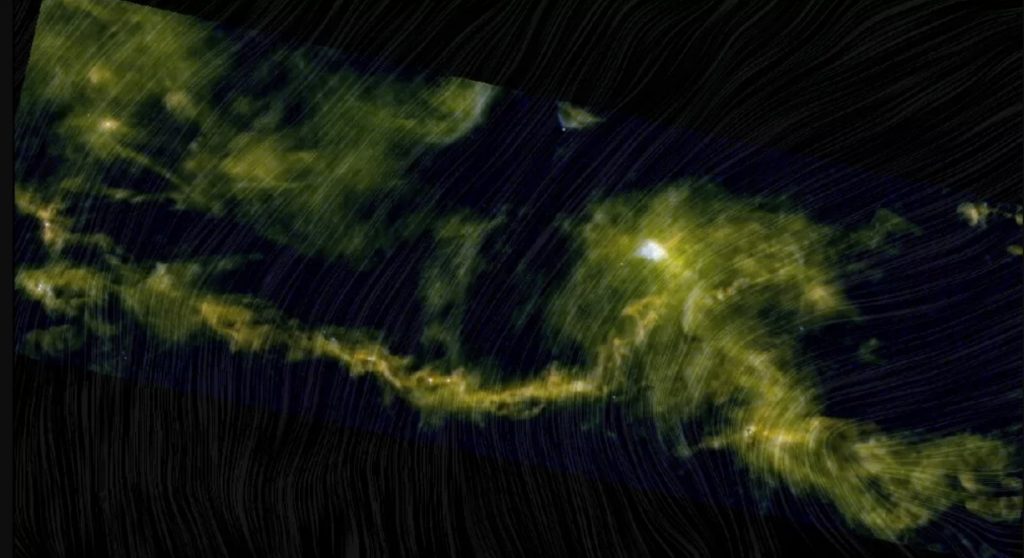
Astronomers have long wondered where high-energy cosmic rays come from within our galaxy.
And now, new observations reveal an unlikely candidate: an otherwise mundane giant molecular cloud.
What are cosmic rays?
Cosmic rays are not rays at all but rather tiny particles cruising through the universe at nearly the speed of light. They can be made of electrons, protons or even ions of heavier elements. They are created in all sorts of high-energy processes throughout the cosmos, from supernova explosions to the mergers of stars to the final insane moments when gas gets sucked up by a black hole.
Cosmic rays come in all sorts of energies, and generally speaking the higher-energy cosmic rays are rarer than their low-energy relatives. This relationship changes in a very slight way at a particular energy — 10^15 electron-volts — which is called the “knee.” The electron-volt, or eV, is just the way that particle physicists enjoy measuring energy levels. For comparison, the most powerful particle collider on Earth, CERN’s Large Hadron Collider, can achieve 13 X 10^12 eV, which is often denoted as 13 tera electron-volts, or 13 TeV.
Rare cosmic rays
Above an energy of 10^15 eV, cosmic rays are much rarer than you would expect.
This has led astronomers to believe that any cosmic rays at this energy level and higher come from outside the galaxy, while processes within the Milky Way are capable of producing cosmic rays up to and including 10^15 eV.
For those of you keeping score at home, whatever is creating these cosmic rays would be in the “peta” range of Greek prefixes, and therefore over 1,000 times more powerful than our best particle accelerators — natural “PeVatrons” roaming the galaxy.
Where are PeV-scale cosmic rays created in the Milky Way?
Despite their energies, it’s hard to pinpoint their origins.
That’s because cosmic rays are made of charged particles, and charged particles traveling through interstellar space respond to our galaxy’s magnetic field.
Thus when you see a high-energy cosmic ray coming from a particular direction in the sky, you actually have no idea where it truly came from — its path has bent and curved over the course of its journey to Earth.
But instead of hunting for cosmic rays directly, we can search for some of their relatives. When cosmic rays accidentally strike a cloud of interstellar gas, they can emit gamma rays, a high-energy form of radiation. These gamma rays shoot straight-line through the galaxy, allowing us to directly pinpoint their origins.
So if we see a source of strong gamma-ray emission, we can look for nearby sources of PeV cosmic rays.
Detailed in an astronomy paper recently, astronomers found a source of gamma rays exceeding 200 TeV, which could only be created by even more powerful cosmic rays — the kinds of cosmic rays that reach up into the PeV scale.
The source, called HAWC J1825-134, lies roughly in the direction of the galactic center. HAWC J1825-134 appears to us as a bright blotch of gamma rays, illuminated by some unknown fount of cosmic rays — perhaps the most powerful known source of cosmic rays in the Milky Way.
A mysterious giant molecular cloud
A few of the usual suspect sources of high-energy cosmic rays sit within a few thousand light-years of HAWC J1825-134, but none of them can easily explain the signal.
For example, the galactic center itself is a known generator of intense cosmic ray action, but it’s way too far away from HAWC J1825-134, so it has no bearing on this measurement.
There are some supernova remnants, and supernovae sure are powerful. But all the supernovae in the region of HAWC J1825-134 went off ages ago — far too long in the past to be creating these high-energy cosmic rays now.
Pulsars — the rapidly spinning dense remnant cores of massive stars — also produce copious amounts of cosmic rays. But those too sit too far away from the source of gamma rays — the energies of the electrons and protons coming off the pulsar just aren’t punchy enough to travel the thousands of light-years to the location of the gamma ray emission.
Surprisingly, the source of these record-breaking cosmic rays appears to be none other than a giant molecular cloud. These clouds are giant, lumbering brutes, filled with dust and gas, that roam the galaxy. They occasionally contract in on themselves and turn into stars, but otherwise they can remain cool and loose for billions of years. Not causing anyone any serious threat — and barely even noticeable unless you have good infrared telescopes — they are the last place you would expect to find such insanely high energies.
Located within the cloud complex is a cluster of newborn stars, but even the crankiest and loudest of baby stars aren’t thought to be powerful enough to launch cosmic rays like this. The researchers themselves admit that they don’t know how this cloud is doing it, but somehow, when nobody was paying attention, it generated some of the most powerful particles in the entire galaxy. Read more: “Arxiv and Space“
Now subscribe to this blog to get more amazing news curated just for you right in your inbox on a daily basis (here an example of our new newsletter).
More mysterious space news on Strange Sounds and Steve Quayle. You can also follow us on Facebook and/ or Twitter. And, by the way you can also make a donation through Paypal. Thank you!













Check out this guy, he has a lot of short video’s on the universe with great explanation, picture’s and graphs. His name is David Butler.
http://www.youtube.com/channel/UCNwSxyl2KmhdAjHLR6xGR0A
it doesn’t bother melanated people just the others.
https://www.christianevidence.net/2019/05/cern-and-bible-prophecy.html?m=1
Look up all the satanic and occult evidence surrounding CERN. You will be hooked by the first paragraph if you choose to read.
Why would you put an idol of shiva, do a satanic ritual, and film it. Those in the know—know what is going on.